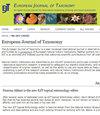生物地理学能帮助保护大黄蜂吗?
IF 1.3
3区 生物学
Q3 ENTOMOLOGY
引用次数: 0
摘要
大黄蜂(Bombus Latreille,1802),因为它们体型大,颜色鲜艳,在与生物学家一致的时间和地点活动,是博物馆藏品中特别有代表性的一群昆虫的一个例子。如果要在物种之间实现更大的可比性,这一点非常重要。大黄蜂也引起了特别的关注,因为它们在北温带地区的授粉具有特别的生态和经济价值,在那里它们正受到越来越大的威胁。我认为,通过了解影响其生物地理历史的不同特征,可以了解有效的保护管理的内容、地点和方式:帮助我们了解其栖息地需求的“森林”,而不仅仅是“树木”。确定合适的栖息地应该是在分类学修订中重建历史生物地理学的一部分。例如,对于大黄蜂来说,生物地理学分析将主要的分类群与富含花朵的低地草原或富含花朵的山地草原联系起来,突出了它们对以下方面的对比要求:巢址、不同深度的花朵、花粉植物科,尤其是早春和夏末花朵对繁殖成功的不同重要性。这种对物种群体的广泛看法有助于从当地的案例研究中筛选出不太重要的特质,以集中保护行动。本文章由计算机程序翻译,如有差异,请以英文原文为准。
Can biogeography help bumblebee conservation?
Bumblebees (Bombus Latreille, 1802), because of their large body size, bright colours and activity at times and places that coincide with biologists, are an example of a group of insects that is particularly well represented in museum collections. This is important if taxonomic revisions are to achieve greater comparability among species. Bumblebees have also attracted particular attention because they are especially ecologically and economically valuable for pollination in north temperate regions, where they are now becoming increasingly threatened. I argue that the what, the where, and the how of effective conservation management may be informed by understanding the divergent characteristics that have affected their biogeographical past: by helping us to see ‘the woods’, not just ‘the trees’, of their habitat needs. Identifying suitable habitat should be part of reconstructing historical biogeography within taxonomic revisions. For bumblebees, for example, biogeographical analysis associates major taxonomic groups either with flower-rich lowland grasslands or with flower-rich montane grasslands, highlighting their contrasting requirements for: nest sites, flowers of different depths, pollen-plant families, and especially the differing importance of early spring and late summer flowers for breeding success. This broad view of species groups helps filter the less important idiosyncrasies from local case studies in order to focus conservation actions.
求助全文
通过发布文献求助,成功后即可免费获取论文全文。
去求助
来源期刊

European journal of taxonomy
ZOOLOGY-
CiteScore
2.30
自引率
8.30%
发文量
173
审稿时长
29 weeks
期刊介绍:
EJT is a fully refereed, international, fully electronic Open Access journal in descriptive taxonomy, covering subjects in zoology, entomology, botany (in its broadest sense), and palaeontology. EJT-papers must be original and adhere to high scientific (content) and technical (language, artwork, etc.) standards. Manuscripts that are clearly substandard in either of these categories will not be sent out for review. EJT is supported by a consortium of European Natural History Institutes, but its scope is global. Both authorship and geographical region of study need not be European. Authors are, however, strongly encouraged to involve European Natural History collections by consulting material or by depositing specimens (e.g. types and figured material) related to their published paper in the collection of a European Natural History Institute.
 求助内容:
求助内容: 应助结果提醒方式:
应助结果提醒方式:


